 Radiance ambient and penumbra test v2.0
Radiance ambient and penumbra test v2.0 Radiance ambient and penumbra test v2.0
Radiance ambient and penumbra test v2.0
Because the scenes that we are interested in rendering are composed of very large numbers of primitives, both near the observer and far away, and as a result, the compiled octree commonly fills up all available RAM (1 GB on my machine); Greg Ward suggested that I set rpict's -aa (ambient accuracy) parameter to zero. This forces an ambient calculation to be made for every intersection of a view ray with a surface (with a few minor exceptions, such as mirrors), instead of computing and caching all of the ambient points. Note that the scene used for these tests in no way fills up available RAM, and a high-quality image can be created in less time using ambient caching.
In addition, because of the inability of simply using the -ds (direct sampling) parameter alone to create smooth penumbras (we have it set at 0.1), we also set the -dj (direct jitter) parameter rather high (0.6).
Thanks to suggestions from the Radiance-Online list, I changed the pixel sample -ps parameter from the Radiance-standard 4 to 1, thus sending a view ray into every image pixel. Renderings took a little longer with this parameter set as such, but the penumbras now appear much better for lower oversampling multipliers. To see the results from the -ps 4 tests, click here.
With these parameters set, we rendered a scene of a modified Sierpinski gasket with a single area light and no sky dome while varying the following parameters:
The rpict statement used is the following:
rpict -vp 3.6 2 1.5 -vd -3.6 -2 -1.1 -vh 25 -vv 25 -ps 1 -ds 0.1 -dj 0.6 -aa 0 -ab N -ad N -x N -y N scene.octOf additional importance is the use of rpict's default values for the following parameters:
-pj 0.67 -pt 0.05 -aw 0 -as 0The perl script used to make the images in this table is called renderall.pl, and the source files are in this directory.
NOTE: The Radiance distribution was compiled with the -DMC option, which enables true Monte-Carlo sampling of specular highlights, penumbras, and the like. This causes no repeatable change in render times.
NOTE: All reported CPU times are from an Athlon XP 2000 processor in a system with 1 GB RAM.
| -ad 4 | -ad 16 | -ad 64 | -ad 256 | |
| 1x final resolution | 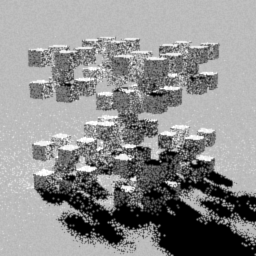 0m1.360s, 44519 bytes |
 0m3.940s, 41738 bytes |
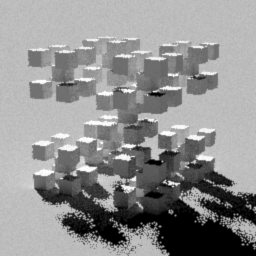 0m22.810s, 37804 bytes |
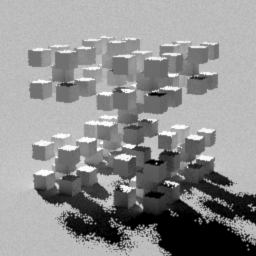 1m10.120s, 36406 bytes |
| 2x final resolution |  0m5.460s, 40406 bytes |
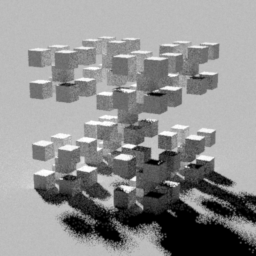 0m15.780s, 37150 bytes |
 1m30.950s, 33799 bytes |
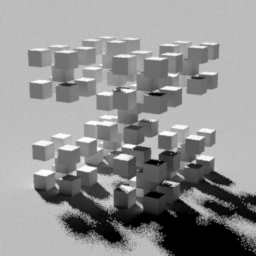 4m39.110s, 32805 bytes |
| 3x final resolution |  0m12.220s, 37332 bytes |
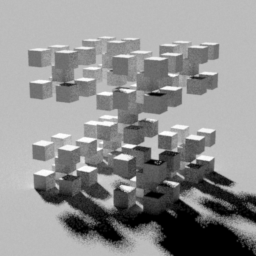 0m35.330s, 34375 bytes |
 3m25.220s, 33799 bytes |
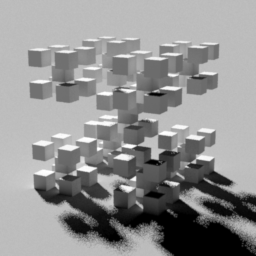 10m28.280s, 30451 bytes |
| 4x final resolution | 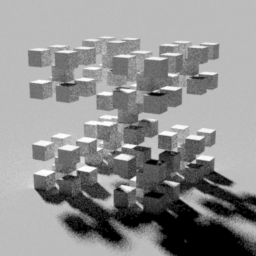 0m21.830s, 35207 bytes |
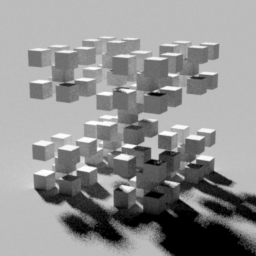 1m2.900s, 32452 bytes |
 6m5.380s, 29878 bytes |
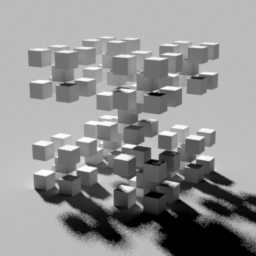 18m36.590s, 28983 bytes |
| 6x final resolution |  0m48.930s, 32650 bytes |
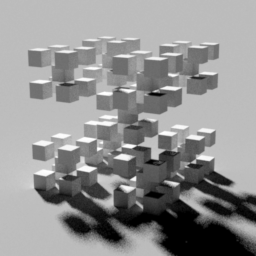 2m21.350s, 30269 bytes |
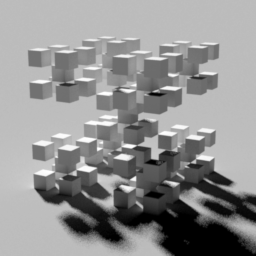 13m38.770s, 28058 bytes |
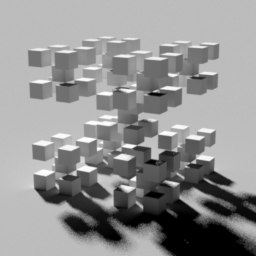 41m50.730s, 27391 bytes |
| 8x final resolution |  1m26.690s, 31005 bytes |
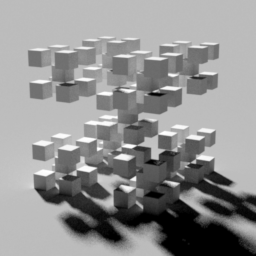 4m10.910s, 28863 bytes |
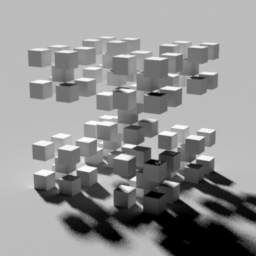 24m17.530s, 26929 bytes |
 74m30.980s, 26363 bytes |
| 12x final resolution | 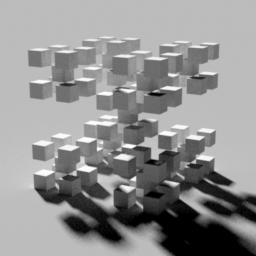 3m15.640s, 29178 bytes |
 9m24.930s, 27282 bytes |
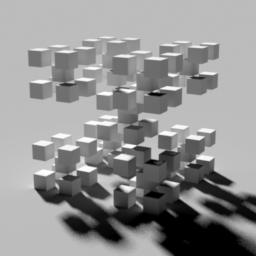 54m33.880s, 25573 bytes |
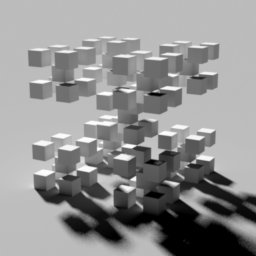 167m13.340s, 25184 bytes |
| -ad 4 | -ad 16 | -ad 64 | -ad 256 | |
| 1x final resolution | 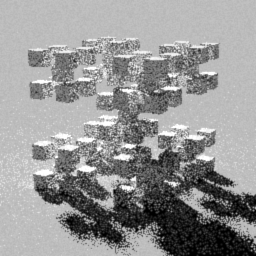 0m2.280s, 47169 bytes |
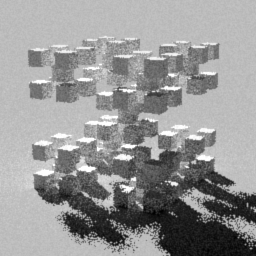 0m17.720s, 43045 bytes |
 3m47.160s, 38187 bytes |
 45m27.320s, 36587 bytes |
| 2x final resolution |  0m9.050s, 41856 bytes |
 1m11.010s, 37643 bytes |
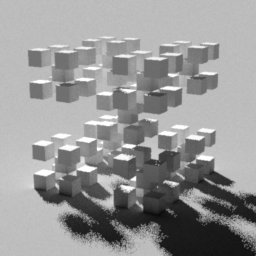 15m13.030s, 33808 bytes |
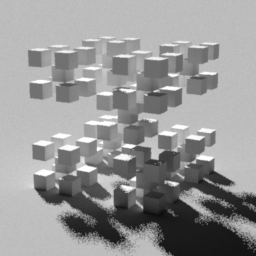 181m39.810s, 32624 bytes |
| 3x final resolution |  0m20.300s, 38146 bytes |
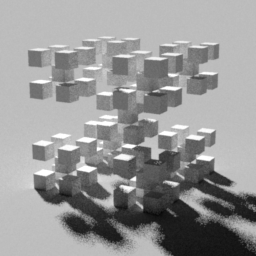 2m39.980s, 34594 bytes |
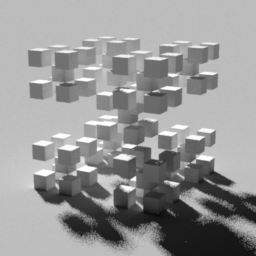 34m6.890s, 31255 bytes |
 410m22.290s, 30117 bytes |
| 4x final resolution | 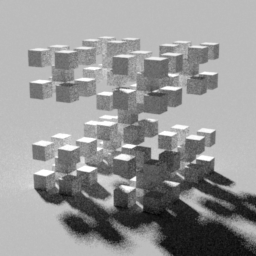 0m36.130s, 35878 bytes |
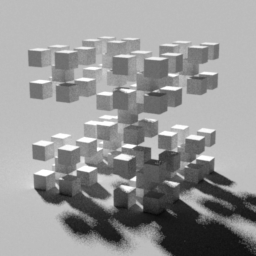 4m44.400s, 32651 bytes |
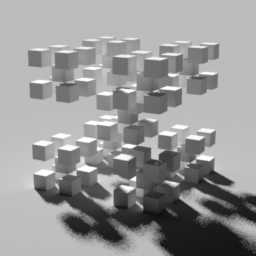 60m48.460s, 29513 bytes |
|
| 6x final resolution | 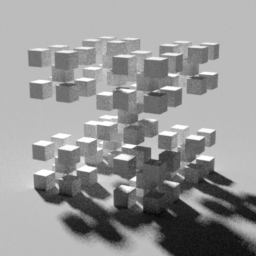 1m20.980s, 33081 bytes |
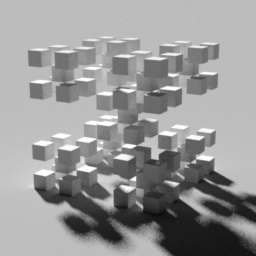 10m41.270s, 30186 bytes |
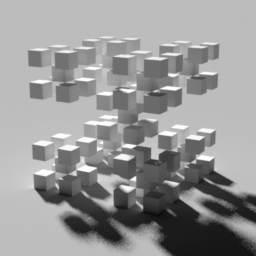 136m30.290s, 27701 bytes |
|
| 8x final resolution |  2m24.390s, 31263 bytes |
 18m58.690s, 28712 bytes |
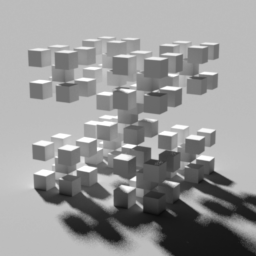 244m32.980s, 26315 bytes |
|
| 12x final resolution | 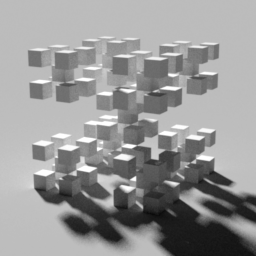 5m24.010s, 29200 bytes |
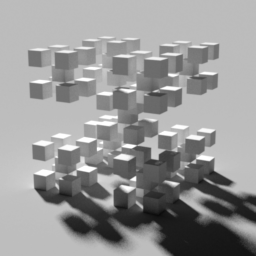 42m34.800s, 26918 bytes |
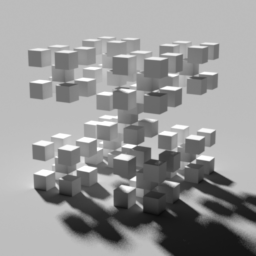 544m40.140s, 24981 bytes |
The effect of changing the ambient bounce setting was somewhat predictable. Noticeable differences exist in the shadow regions between otherwise-equivalent images when the parameters is changed from 1 to 2. Much less difference is seen as the parameter is raised to 3, definitely not enough difference to warrant the increase in render time. This parameter was not the main focus of this test, though. It was mainly used to try to affect the influence of -ad on the images.
The effect of the -ad is surely the most interesting result from this test. At 1x resolution, obviously, the low sampling used for the -ad=4 and 16 cases causes clear speckling of the final image; while -ad 64 and -ad=256 create images with very smooth intensity gradations. Obviously, if penumbras were not called for, one would need no more than 3x oversampling and -ad of 64.
It would be important to note that the PNG file size seems to be a fairly good rating of the overall quality of the image. Any images with file sizes less than 32000 appear to be very high quality, while file sizes under 30000 appear nearly perfect. We shall use this system as a quality parameter later.
Notice that when oversampling is doubled (1x to 2x, or 3x to 6x), four times as many view rays are shot through each pixel window, making the primary contribution of ambient rays equivalent to the next level tested (-ad 4 becomes -ad 16, etc.), but the render time for these "equivalent" renderings strongly favors the one with higher oversampling and less ambient divisions! This is more evident for the cases with more ambient bounces, so let's start with one ambient bounce, and look at the numbers:
| Oversampling | -ad | CPU time | file size |
| 1x | 256 | 1m10.120s | 36406 |
| 2x | 64 | 1m30.950s | 33799 |
| 4x | 16 | 1m2.900s | 32452 |
| 8x | 4 | 1m26.690 | 31005 |
As you can see, the render times are roughly equivalent, as would be expected with only one ambient bounce allowed. Additionally, the file sizes decrease significantly, likely due to both a smoother penumbral shadow and smoother intensity gradients on the faces. We found that these files also appeared smoother and more attractive.
When we look at images rendered with two ambient bounces, we should expect some differences. Whereas the first bounce should shoot an equivalent number of rays into the hemisphere, the second bounce should shoot fewer rays as -ad goes down. Theoretically, this should lead to decreased rendering times and reduced image quality.
| Oversampling | -ad | CPU time | file size |
| 1x | 256 | 45m27.320s | 36587 |
| 2x | 64 | 15m13.030s | 33808 |
| 4x | 16 | 4m40.400s | 32651 |
| 8x | 4 | 2m24.390s | 31263 |
Instead, what we see is sublinear decrease in render times (meaning that the reduced weight of the second bounce rays allows more at -ad 64 to be ignored), and an increase in image quality (though, again, that could be caused by the smoother penumbras). The effect of this method is to create a system by which we can force more ambient rays per pixel at the first bounce (where their visual effect is greater), and fewer for the second bounce and beyond (where visual effect is calculable, but less important).
As an example, the image linked from the thumbnail above is cropped from a 4000x4000 pixel image, which came from a 16000x16000 pixel original. The scene is composed of 531441 cubes, or about 3.2 million primitives. It was rendered with default Radiance options (including -ps 4), except for -ab 2 -aa 0 -ad 8. It took 16.247 hours to render. I can't even begin to calculate how long this scene would take to render using ambient value caching.